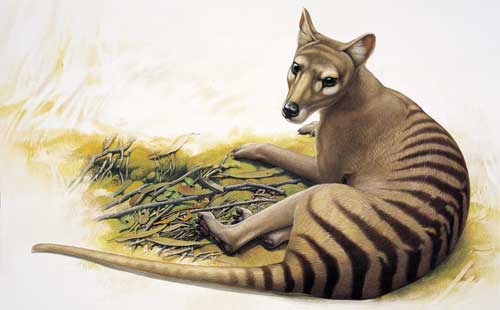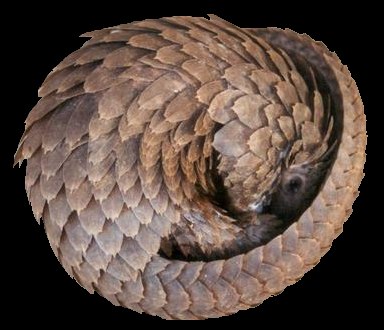Small, deep-sea cephalopod found throughout the temperate and tropical oceans of the world. Unique retractile sensory filaments justify the Vampire Squid's placement in its own order: Vampyromorphida(formerly Vampyromorpha), which shares similarities with both squid and octopuses
2. Thylacine
was the largest known carnivorous marsupial of modern times. It is commonly known as the Tasmanian tiger (because of its striped back), the Tasmanian wolf, and colloquially the Tassie tiger or simply the tiger.[6] Native to continental Australia, Tasmania and New Guinea, it is thought to have become extinct in the 20th century. It was the last extant member of its genus, Thylacinus, although several related species have been found in the fossil record dating back to the early Miocene.
3. Gharial
is the only surviving member of the once well-represented family Gavialidae, a long-established group of crocodilians with long, slender snouts. The gharial is listed as a critically endangered species by IUCN.
The gharial is one of the three crocodilians found in India, the others being the Mugger crocodile and the Saltwater crocodile.It is one of the longest of all living crocodilians.
4.
Wombat
Wombats are Australian marsupials; they are short-legged, muscular quadrupeds, approximately 1 metre (39 in) in length with a very short tail. They are found in forested, mountainous, and heathland areas of south-eastern Australia and Tasmania. The name wombat comes from theEora Aboriginal community who were the original inhabitants of the Sydney area.
5. Naked mole rat
The naked mole rat (Heterocephalus glaber), also known as the sand puppy or desert mole rat, is a burrowing rodent native to parts of East Africa and the only species currently classified in the genus Heterocephalus. It is one of only two known eusocial mammals (the other being the Damaraland mole rat) and has a highly unusual set of physical traits that enables it to thrive in a harsh, underground environment, including a lack of pain sensation in its skin and a very low metabolism.
6. Echidna
also known as spiny anteaters, belong to the family Tachyglossidae in the monotreme order of egg-layingmammals. There are four extant species, which, together with the Platypus, are the only surviving members of that order and are the only extant mammals that lay eggs.Although their diet consists largely of ants and termites, they are only distantly related to the true anteatersof the Americas. They live in New Guinea and Australia. The echidnas are named after a monster in ancient Greek mythology.
7. Pangolin
is a mammal of the order Pholidota. There is only one extantfamily (Manidae) and one genus (Manis) of pangolins, comprising eight species. There are also a number of extinct taxa. Pangolins have largekeratin scales covering their skin and are the only mammals with this adaptation.They are found in tropical regions of Africa and Asia. The name "pangolin" derives from the Malay word pengguling ("something that rolls up").





